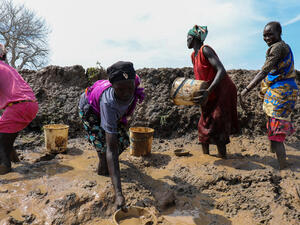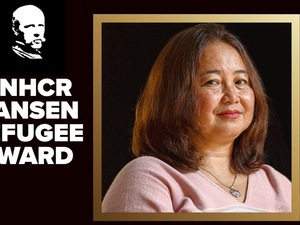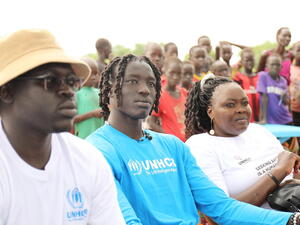UNHCR aid reaches uprooted Somalis as total number of people displaced by recent fighting tops 320,000
UNHCR aid reaches uprooted Somalis as total number of people displaced by recent fighting tops 320,000

UNHCR and NGO staff load relief and medical items onto trucks in Liboi, Kenya, to assist thouands of displaced people across the nearby border in the Somali town of Dobley.
NAIROBI, Kenya, April 20 (UNHCR) - UNHCR distributed much-needed relief supplies for a second day Friday to thousands of desperate displaced people from Somalia's strife-torn capital, where fighting has sent more than 321,000 people fleeing since February.
According to new figures provided by a network of aid agencies and compiled by UNHCR, the overall estimate of people forced to flee Mogadishu since fighting began there in February has climbed substantially, with the increase particularly significant in the regions of Galgaduud and Mudug. Of the total of 321,000 displaced, an estimated 111,000 people have headed to the nearby Shabelle provinces (43,000 in Middle Shabelle and 68,000 people in Lower Shabelle). Another 109,000 people have gone to Galgaduud region; 38,000 to Mudug; 25,000 to Bay region; and 24,000 to Hirran region. Another 14,000 are in other regions.
Some 41,000 of the displaced in Lower Shabelle are in the district of Afgooye, 30 km west of Mogadishu. On Thursday, UNHCR began distribution of relief supplies to thousands of people in Afgooye. However, an explosion Thursday afternoon on the main road linking Afgooye and the capital cut the main link to the small town, now crowded with internally displaced people. No traffic was reported along the road on Friday morning, and vehicles were forced to use insecure alternative routes through the bush.
UNHCR officials expressed concern that the severed road link would make it even harder for aid agencies to bring supplies from warehouses in Mogadishu.
"On the first day of the distribution Thursday, UNHCR and its Somali NGO partners were able to reach 1,500 families, or about 9,000 people," UNHCR spokesman Ron Redmond told reporters Friday in Geneva. "All of them were living outdoors under trees or simply out in the open. By this morning, many of these families had already prepared makeshift shelters with some of the plastic sheeting which they received from UNHCR yesterday. We plan to continue with the distribution today with the hope of reaching another 500 families - 3,000 people - all of whom are living outdoors in Afgooye."
He said the approach of the rainy season made the need for shelter material more pressing as families living under the trees are exposed to the scorching sun, heavy rains and the chilling nights. In addition to plastic sheeting, UNHCR and its partners have been able to distribute sleeping mats and mosquito nets.
The distribution in Afgooye was expected to continue though the weekend using aid stocks airlifted into the Somali town of Baidoa from UNHCR's emergency stockpiles in Dubai. The stocks include blankets, plastic sheeting, jerry cans and kitchen sets for up to 20,000 people. UNHCR plans to airlift more relief supplies from Dubai next week. The extra supplies should cover an additional 15,000 displaced people.
On Wednesday, UNHCR was able to send two truckloads of much-needed relief and medical supplies from Dadaab refugee camp, in north-eastern Kenya, to Dobley, a small Somali border town 18 km from the Kenya-Somali border. The town is struggling to cope with a recent influx of an estimated 4,000 displaced Somalis and an outbreak of diarrhoea which has so far claimed the lives of six children. Some of the supplies were distributed at an isolation camp set up by the community on the outskirts of the town to stem the spread of the disease in the town. NGOs report that there are now 50 people hospitalised in the makeshift hospital there.
Because of security concerns, the UN is unable to work in these parts of Somalia and is providing assistance through Somali NGOs.
By Catherine Weibel in Nairobi, Kenya









